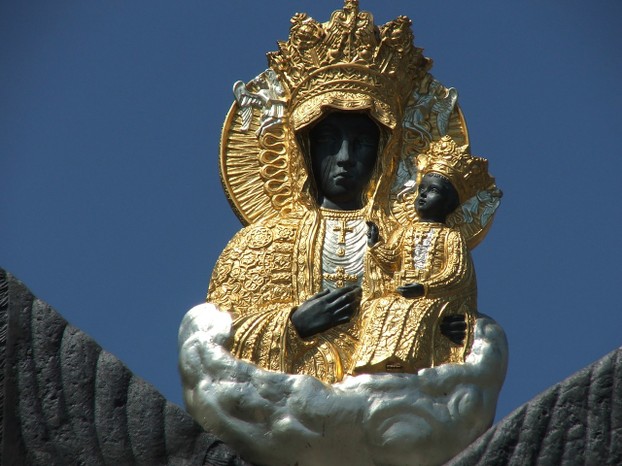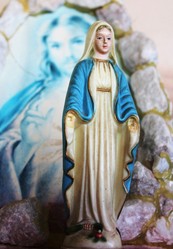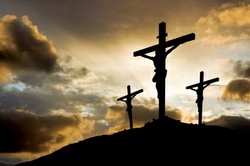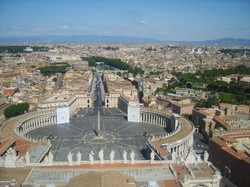Yet while the origins of the cultus of Mary are rooted in popular devotion, it is supported by Scripture and Christian theology.
There are many titles of honour given to Mary, but in the litany,a long list of titles sometimes used in Catholic ceremonies as an invocation, she is called "ark of the covenant." and this title is fully scriptural. In the Old Testament the ark was the bearer of God's presence in Israel, but for some unknown reason it disappeared in Israel's wars and was never seen again. But at the incarnation Mary became the bearer of God's presence, carrying him in her womb, so symbolically she did the job of the ark and therefore the church rightly gives her this title.
This takes us to Mary's vital role in salvation history, the story of God's dealings with humankind. They believe that at the Annunciation [recounted in Luke chapter 1] she was visited by the archangel Gabriel to announce to her that she was to be the mother of the messiah, and her response was to willingly accept the tremendous and daunting challenge. Some Christians believe that without her willing acceptance of her role in God's plan the incarnation, God's becoming human in Jesus Christ, might not have happened. They believe that God was waiting on someone to say yes, and that someone was Mary. She is therefore a major player in salvation history, clearly subordinate to God, but an important human agent of God's will.
The Orthodox Church, which in many teachings is similar to the Catholic Church, rates Mary very highly and offers her significant devotion, awarding her the title of Theotokos, the bearer of God. This title is not formally used in the Catholic Church, but it is known, valued and respected by Catholics, who sometimes use it.
I was in Crete on August 15th one year, the feast of Mary's assumption into heaven and became aware of just how much the Orthodox celebrate the Theotokos. The traditions of the Palestinian church were that she was so holy that God took her straight to heaven, body and soul, when she died. As she is recorded as having died, it seems that the belief is that she was accorded the privilege of sharing in Christ's resurrection ahead of his other followers. The Christian teaching is that we will all resurrectas he did, but she was privileged to be resurrrected earlier than others.
The Reformation caused a decline in devotion to Mary, as the reformers smashed many of her shrines, including England's shrine at Walsingham in East Anglia, and I do not think that this has been good for the church, for it cut off a popular and emotionally satisfying aspect of Christian devotional living. Marian gardens were lost and there are few left. A few have been revived in England and some remain in monasteries in Europe. But the cult of Mary still retains its power to inspire devotion and her shrines, such as Lourdes and Fatima, are still popular.







 Pilgrimage. A review18 days ago
Pilgrimage. A review18 days ago
 Leo the Fourteenthon 05/09/2025
Leo the Fourteenthon 05/09/2025
 The Melsonby Hoardon 03/25/2025
The Melsonby Hoardon 03/25/2025



Comments
I think that there are nat8vity scenes in St Peter's, but I am unsure.
Thank you for your comment below, in answer to my previous observation and question.
This question deals with your wizzley even as it deals with Our Lady Mary and with honoring her.
Is there any ornamental Holy-Family indication -- such as Nativity figures and settings -- during the Advent-Christmas season in Vatican City?
The question centres on whether the term boddjisattva can be directly transferred into a non-Buddhist context. It indicates that the recipient of the term has forgone nirvana to serve others. The term might be stretched to indicate Christ's kenosis, his self-emptying to serve others, but the term does not in my view sit easily in the Christian world-view.
My comment immediately below correlates with something further concerning Buddhism and Hinduism.
Might Our Lady Mary manifest inaccurately, not as fully respectfully and reverentially as she must, as a boddhisattva and as the mother of a boddhisattva, which title would be second to buddha?
It always saddens me that Buddhism and Hinduism see Jesus Christ and Our Lady Mary thusly.
The introductory paragraph associates respectful, reverential appreciation of Our Lady Mary with Anglican, Catholic, Old Catholic, Orthodox Christians and with Muslims.
Might it also be possible to include Buddihism and Hinduism?
Our Lady Mary receives respectful, reverential recognition as compassionate boddhisattva Guanyin in Buddhism and as Lady of Velankanni in Hinduism.
Thank you, Frank!
Somewhere in Second Maccabees, found in Catholic Bibles, but accounted apocrypha by Protestants, is the saying "It is a holy and wholesome thought to pray for the dead so that they can be loosed from their sins."
Prayer for the dead arises out of the Catholic conception of the afterlife. While Protestants think in terms of judgement then either heaven or hell, Catholics think that there is an intermediate state called purgatory, in which progress is made. Thus in Protestantism there is no space for prayers for the dead, which are regarded as unnecessary for people in heaven and pointless for those in hell, Catholics believe in assisting passage through purgatory. My own opinion is that purgatory covers a variety of yet unknown possibilities. God's wisdom far exceeds our human imaginings and theological theories.
Hi Frank, I didn't know, among other things, that St. Mary is the ark of the covenant. How very interesting.
I'm wondering about praying for the dead, which we do. We light candles for the living and for the dead and say prayers as we do so. Is praying for the dead mentioned in the Bible in any way? How did it arise? Pagan rituals?
The original holy house was completely destroyed. Sir Francis took his surname from where his ancestor originated, just as my name derives from people who dwelt in Beswick, but most English people did not even by the mediaeval period dwell in their ancestral village, so no, he had no connection with Walsingham other than an ancestral one.
Mary is a fascinating character, and I do not believe that we have any true understanding of the mystery of her person.